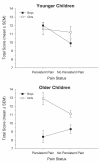Persistent pain in a community-based sample of children and adolescents
- PMID: 22059200
- PMCID: PMC3206778
- DOI: 10.1155/2011/534652
Persistent pain in a community-based sample of children and adolescents
Abstract
Background: Very few studies have investigated the psychological factors associated with the pain experiences of children and adolescents in community samples.
Objectives: To examine the lifetime prevalence of, and psychological variables associated with, persistent pain in a community sample of children and adolescents, and to explore differences according to sex, age and pain history.
Methods: Participants completed the Childhood Anxiety Sensitivity Index (CASI), the Child Pain Anxiety Symptoms Scale (CPASS), the Multidimensional Anxiety Scale for Children-10 (MASC-10), the Pain Catastrophizing Scale for Children (PCS-C) and a pain history questionnaire that assessed chronicity and pain frequency. After research ethics board approval, informed consent⁄assent was obtained from 1022 individuals recruited to participate in a study conducted at the Ontario Science Centre (Toronto, Ontario).
Results: Of the 1006 participants (54% female, mean [± SD] age 11.6±2.7 years) who provided complete data, 27% reported having experienced pain that lasted for three months or longer. A 2×2×2 (pain history, age and sex) multivariate ANOVA was conducted, with the total scores on the CASI, the CPASS, the MASC-10 and the PCS-C as dependent variables. Girls with a history of persistent pain expressed higher levels of anxiety sensitivity (P<0.001) and pain catastrophizing (P<0.001) than both girls without a pain history and boys regardless of pain history. This same pattern of results was found for anxiety and pain anxiety in the older, but not the younger, age group.
Conclusions: Boys and girls appear to differ in terms of how age and pain history relate to the expression of pain-related psychological variables. Given the prevalence of persistent pain found in the study, more research is needed regarding the developmental implications of persistent pain in childhood and adolescence.
HISTORIQUE :: Très peu d’études ont porté sur les facteurs psychologiques associés aux expériences de douleur d’enfants et d’adolescents provenant d’échantillons communautaires.
OBJECTIFS :: Examiner la prévalence à vie et les variables psychologiques de la douleur persistante dans un échantillon communautaire d’enfants et d’adolescents et explorer les différences selon le sexe, l’âge et les antécédents de douleur.
MÉTHODOLOGIE :: Les participants ont rempli l’indice de sensibilité à l’anxiété de l’enfance (CASI), l’échelle de symptômes d’anxiété liés à la douleur chez l’enfant (CPASS), l’échelle d’anxiété multidimensionnelle pour les enfants-10 (MASC-10), l’échelle de catastrophisation de la douleur chez les enfants (PCS-C) et un questionnaire d’antécédents de douleur qui évaluait la chronicité et la fréquence de la douleur. Après l’approbation d’un comité d’éthique de la recherche, 1 022 personnes recrutées pour participer à une étude menée à l’Ontario Science Centre de Toronto, en Ontario, ont donné leur autorisation ou leur consentement éclairé.
RÉSULTATS :: Sur les 1 006 participants (54 % de femmes, âge moyen [±ÉT] de 11,6±2,7 ans) qui avaient fourni des données complètes, 27 % ont déclaré avoir ressenti de la douleur pendantau moins trois mois. Les chercheurs ont effectué une ANOVA multivariée 2×2×2 (antécédents de douleur, âge et sexe), les indices totaux du CASI, de la CPASS, de la MASC-10 et de la PCS-C servant de variables dépendantes. Les filles ayant des antécédents de douleur persistante exprimaient des taux plus élevés de sensibilité à l’anxiété (P<0,001) et de catastrophisation de la douleur (P<0,001) que les filles n’ayant pas de tels antécédents et que les garçons, quels que soient leurs antécédents. Les chercheurs ont constaté le même schème de résultats relativement à l’anxiété et à l’anxiété de la douleur au sein du groupe plus âgé, mais pas du groupe plus jeune.
CONCLUSIONS :: Les garçons et les filles semblent différents pour ce qui est du lien entre l’âge ainsi que les antécédents de douleur et l’expression des variables psychologiques liées à la douleur. Étant donné la prévalence de douleur persistante constatée dans l’étude, plus de recherches s’imposent sur les répercussions de la douleur persistante sur le développement pendant l’enfance et l’adolescence.
Figures



References
-
- Huguet A, Miró J. The severity of chronic pediatric pain: An epidemiological study. J Pain. 2008;9:226–36. - PubMed
-
- Perquin CW, Hazebroek-Kampschreur AAJM, Hunfeld JAM, et al. Pain in children and adolescents: A common experience. Pain. 2000;87:51–8. - PubMed
-
- Perquin CW, Hunfeld JAM, Hazebroek-Kampschreur AAJM, et al. The natural course of chronic benign pain in childhood and adolescence: A two-year population-based follow-up study. Eur J Pain. 2003;7:551–9. - PubMed
-
- Hunfeld JAM, Perquin CW, Duivenvoorden HJ, et al. Chronic pain and its impact on quality of life in adolescents and their families. J Pediatr Psychol. 2001;26:145–53. - PubMed
Publication types
MeSH terms
Grants and funding
LinkOut - more resources
Full Text Sources
Medical

